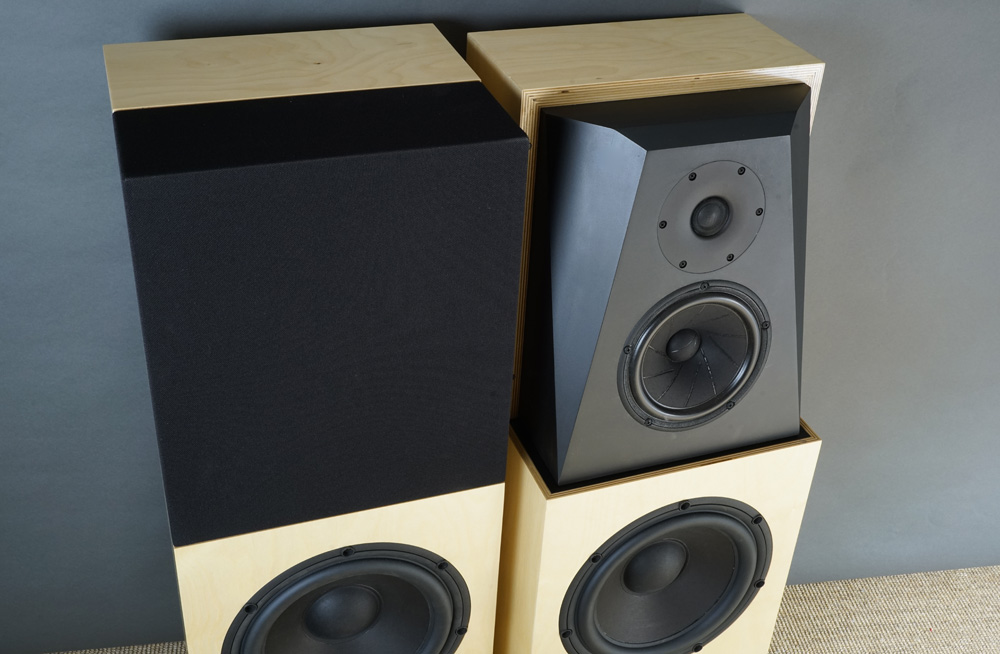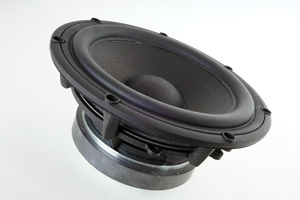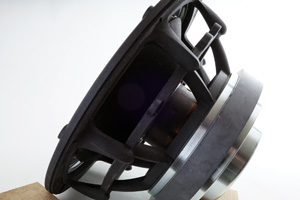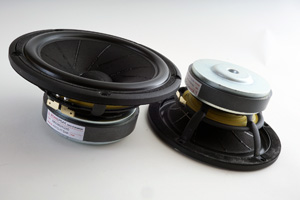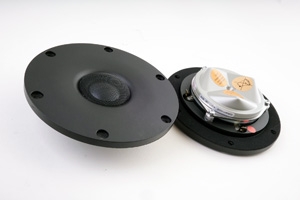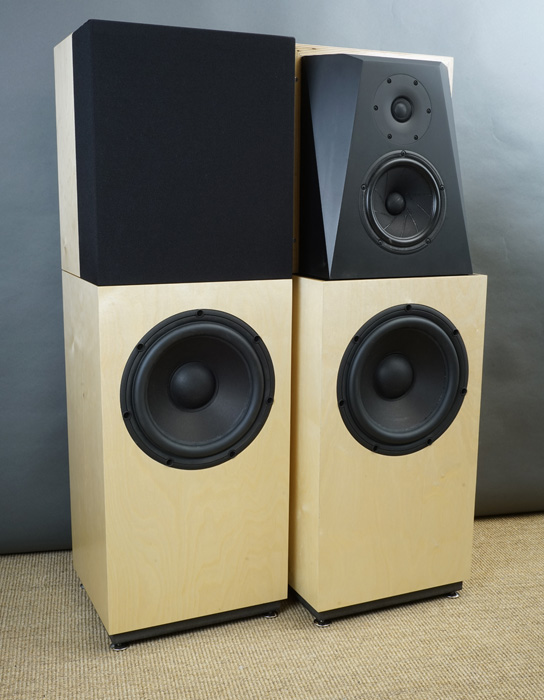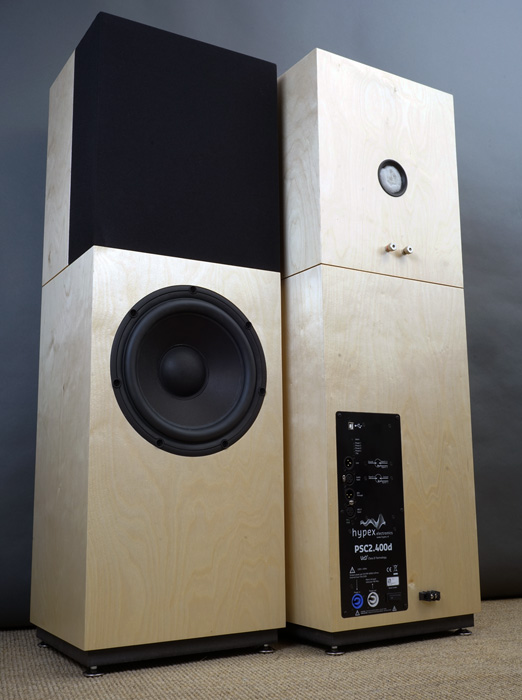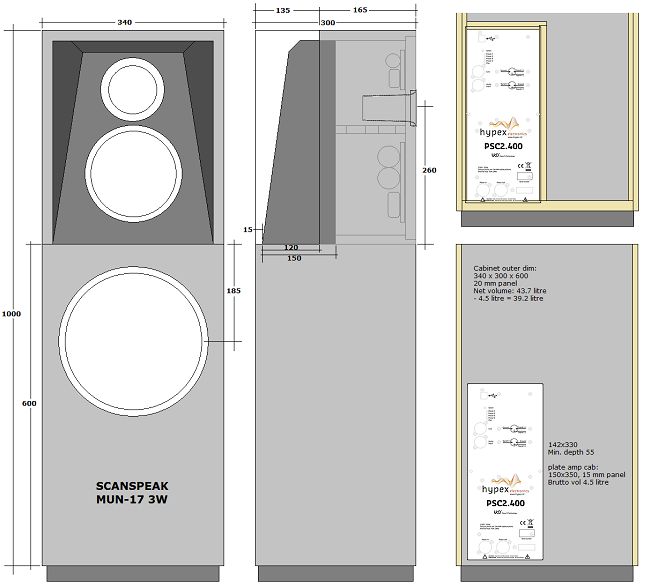DIY Loudspeakers: HOME INDEX UPDATES RESPONSE WHAT'S NEW
ScanSpeak MUN17-3W
Copyright 2017-21 © Troels Gravesen
Kit no longer supported
by Jantzen Audio.
Kit Instruction can be bought for 100€, PayPal transfer.
Go to on this page:
DRIVERS
CROSSOVER
CABINET
WORKSHOP IMAGES
MEASUREMENTS
SPEAKER-KIT
CROSSOVER LAYOUT
This speaker was designed for the ScanSpeak trade visitor exhibition at
the Munich 2017 High-End event. The primary product here is the
28W/4878T00 bass driver, filling the gap between the 26W and 32W bass
drivers.
The midrange driver is a variant of the 18M/4631T00 driver, but here in
an 8 Ohm version, better suited the target system sensitivity. Maybe the
kind ScanSpeak guys got tired of hearing my grumpy comments to the
abundance of 4 Ohms midrange drivers and made an 8 Ohm version. I'm
happy! For tweeter there was no doubt it had to be the Be dome
D2908/714000. Only constraints to the design was a closed box for the
bass driver. Everything else was up to my imagination.
Let's start with the bass driver. This is a sandwich cone driver with a
whopping 3" voice coil and 4 Ohms impedance. Sensitivity is 88.3 dB/2.8V
as an average of response at 300-1000 Hz. A closed box of 40 litres
makes F3 = 42 Hz. Not bad at all - and we're going to extend this by
tweaking the Hypex modules driving the unit. Further TS data below.
40 litre is not a whole lot, thus allows for a very compact design.
Overall dimensions are 100 x 34 x 30 cm - and there's a grille for the
MT section. High WAF! I didn't make a grille for the bass driver, but
obviously no problem in doing so.
This is the first time I use the 18M midrange drivers and only reason for not doing so was the 4 Ohm impedance requiring excessive attenuation to fit any ~88-89 dB design. It may be prejudice, but I don't like excessive attenuation for midrange drivers. Even the 8 Ohm version would by standard crossover design require some attenuation, but here - after quite a lot of modeling - I decided to use a baffle step compensation circuit to control amplitude and get the target SPL.
Sound:
This 18M came as a pleasant surprise! It surely rivals my favourite
AudioTechnology 18H52 for midrange. It has all the virtues of a
high-quality midrange with superb detail, transparency and an overall
ear-friendly presentation. With regard to frequency response it's
probably the smoothest 6" midrange driver on the market, making
crossover work very easy. The low-pass section of a midrange crossover
can often be a real pain, rolling off too fast or we can't get the
damned thing stopping again. Not this one.
I render this speaker in the top three of any speaker I've ever made.
The midrange-treble transparency is astonishing to my ears.
As can be guessed from the crossover layout we only need 66 uF series
capacitors for the midrange saving us some 150 EUR compared to most of
my larger 3-/4-ways requiring 88 uF with the same 200 Hz point of
crossover.
Tuning the bass roll-off was easy as we can manipulate the driver
to our liking in the Hypex software.
The 28W sandwich cone, the closed box and the Hypex module delivers a
firm and punchy bass and I
can't tell how it overall sounds as it makes no sense describing sound.
Even if I wrote a book on the sound, you wouldn't know until you heard
it yourself.
Only limitation I can point to is the quality of the amplifier you put
in front of the midrange-tweeter. Be prepared you can feed it the best
money can buy and you don't need humongous amounts of watt to drive the
MT section. Some 20+ high-quality watts can do.
My GlowMaster just loves this MT section with its fairly high impedance
profile!
Basics:
You're likely to let go of 3100 EUR for Hypex modules and drivers. On
top of this
crossover components and cabinet materials.
3-way speaker from 11" + 7" + 1" drivers.
System sensitivity: 88 dB/2.8V/1 meter.
Impedance: 4 Ohms for bass, 8 Ohms for MT section, minimum 5.5 Ohms @
400 Hz.
Point of crossover: 200 and 2,000 Hz.
Power requirement: 20+ watts/channel.
Pre-amp: Line stage for running the Hypex modules.
Power handling:
A lot! Please
also read this:
http://www.troelsgravesen.dk/power-handling.htm,
and remember any burned driver is a misused driver. Having a dedicated
plate amp for the bass, means you can have a smaller amplifier for the
midrange/tweeter, e.g. 20-40 wpc.
As always: Any change to front panel design and drivers'
placement and you need a new crossover and I can't help.
Please do read before asking questions:
http://www.troelsgravesen.dk/crossovers.htm
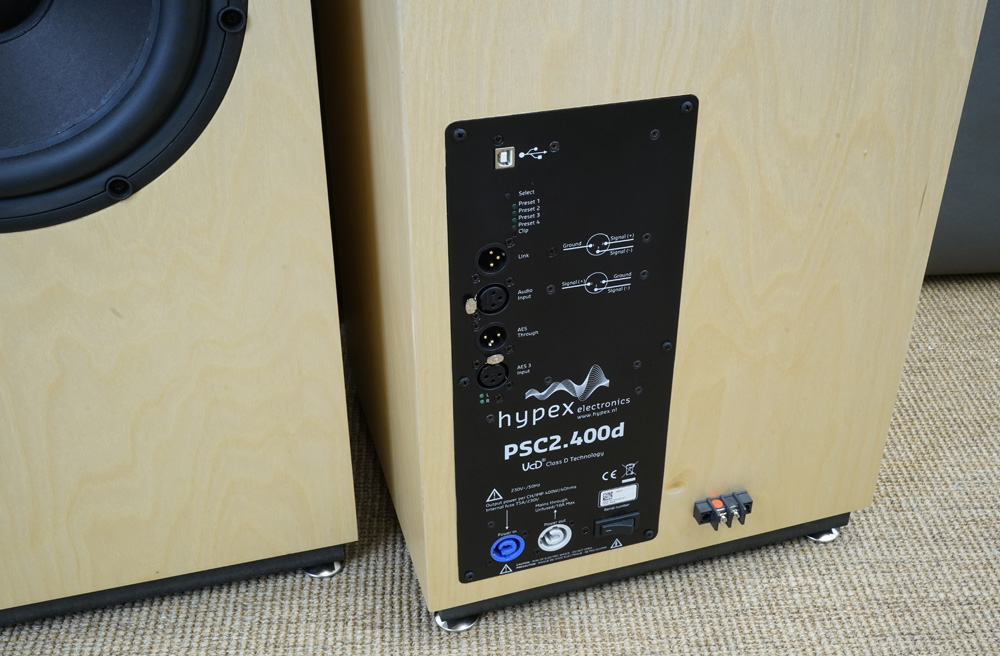
The terminals next to the Hypex are connected to the channel 1 amplifier
for feeding the MT section if needed.
The Hypex PCS2.400d is discontinued. Use Hypex FUSION FA501 in
replacement.
Go to FA501 page
here.
Download specs: 28W/4878-T00 18M/8631-T00 D2908/714000
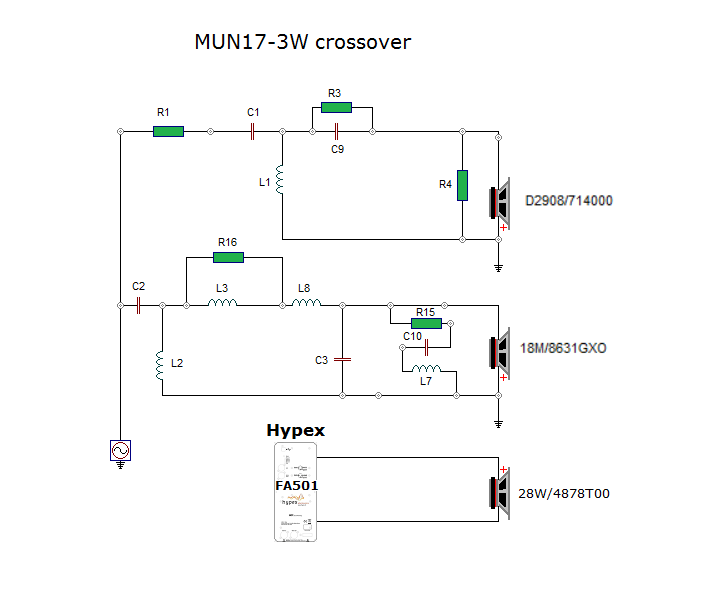
If you use a tube amp for the MT section you may add a 1 kOhm resistors
across speaker terminals or on the crossover board as some tube amp
designers have concerns about a tube amp running a pure capacitive load.
I never had any problems with this from my EAR-861.
click images to view large
The cabinets were made from 20 mm Baltic birch and 25 mm black MDF for the front panel of the midrange-tweeter section. The bass cab is simplicity itself. 60 x 34 x 30 cm. Make a compartment for the Hypex module to be sealed off from the heavy pressure of bass driver. Brace it well! I wouldn't hesitate to recommend 25 mm MDF all over, just extend depth to make some 38-40 liter net volume.
As always you have to stick to the front panel dimensions and drivers'
layout of the MT section to make the crossover work as intended! Too
many think there's free ride here - and there isn't! Any change and you
need a new crossover - and I can't help. Please read this file
carefully: http://www.troelsgravesen.dk/crossovers.htm
I've seen some sad examples recently of people spending 3+ kEUR and
changing the design to such extent they for sure never hear what it was
supposed to. Acoustics can't be fooled.
The front panel chamfering here was made on a table saw, but can be made
very simple from only chisel, planer and sandpaper - and elbow grease!
Read
here.
Check out this file regarding construction tips:
http://www.troelsgravesen.dk/tips.htm
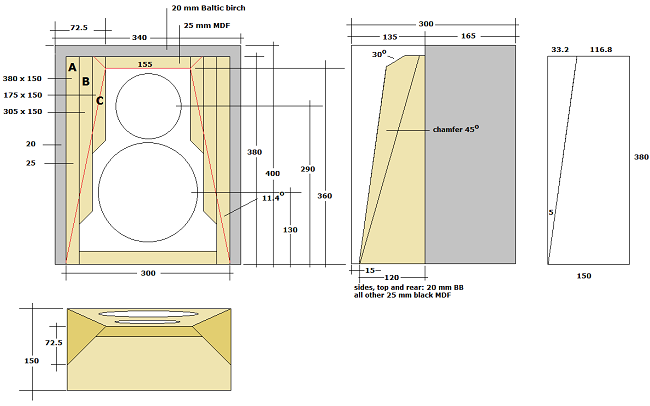
Click image to view large
Follow the design of the MT cab carefully! Important for frequency
response and crossover.
Assuming 25 mm MDF available.
1. Start cutting a piece of 300 x 400 mm for the front panel and cut
ends 5 deg. so that height is 380 mm when upright and tilted.
2. Do the driver routings before going further.
3. Cut the side panels A, 135 (150-25) x 380 mm and cut
one side 5 deg. and attach to front panel with tape.
4. Cut bottom panel and tope panel and make sure everything fit
together. Glue together and you now have the basic frame for the
mid/tweeter section.
5. Cut the side panels B and C and
glue to frame.
6. Chamfer top of front panel 30 deg.
7. Chamfer sides 45 deg. Easiest way is to do this is by hand. Check
this file:
http://www.troelsgravesen.dk/tips.htm#Faceting All you need is
chisel, hammer and sandpaper.
Hypex FUSION AMP/DSP
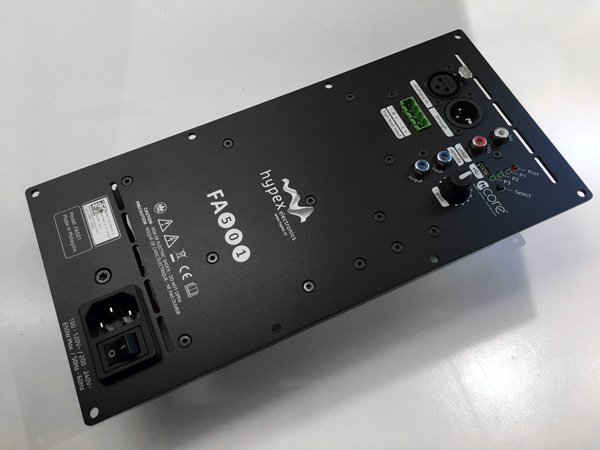
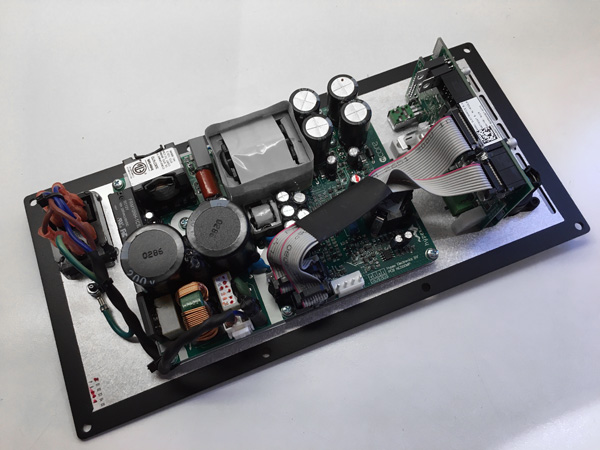
The MUN-17 has been updated with the Hypex FUSION FA501 plate amp/DSP
module.
Go to FA501/FA251 page for info:
http://www.troelsgravesen.dk/FUSION_FA251.htm
(FA251 and FA501 are the same except for
power rating)
I suggest running the Hypex module from the speaker cables, high-level input. The program below is designed for this option.
Download MUN-17 program
here.
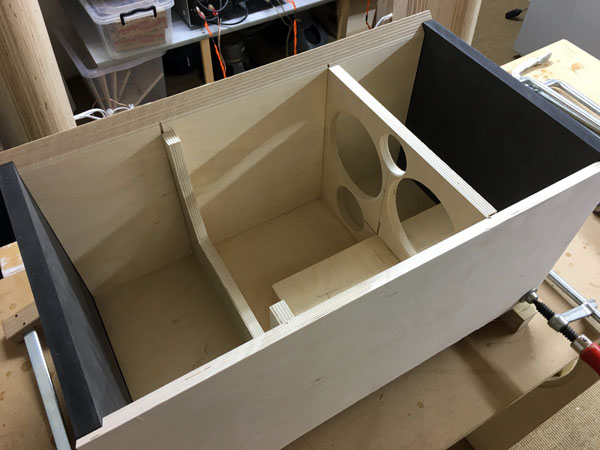
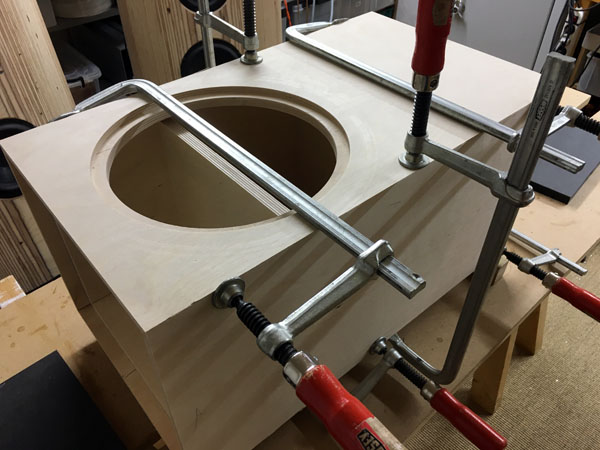
The bass cab was made from 20 mm BB and I used 19 mm black MDF for top
and bottom.
I suggest adding further bracing to the top panel.
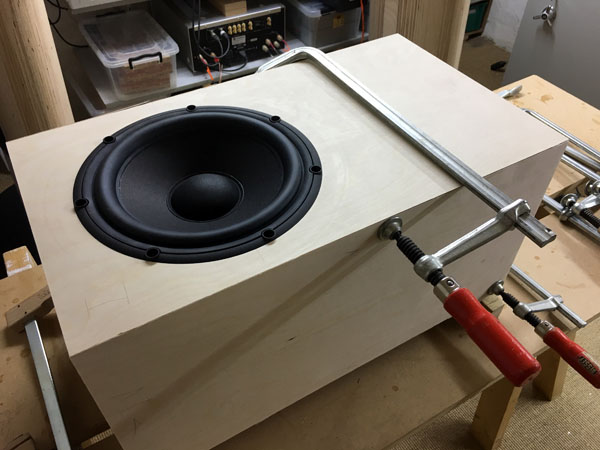
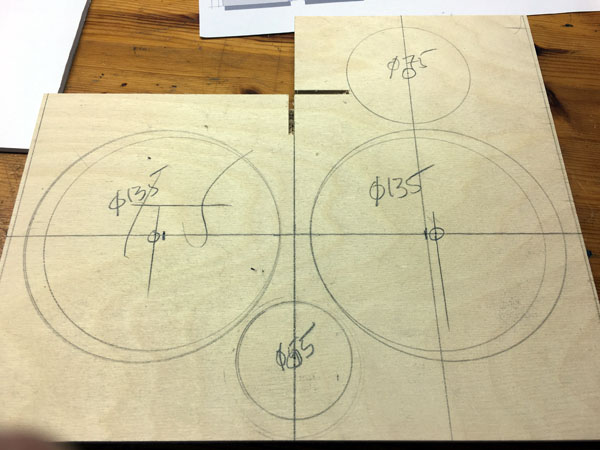
To the right the lower brace. Holes are Ø135, 55 and 75 mm.
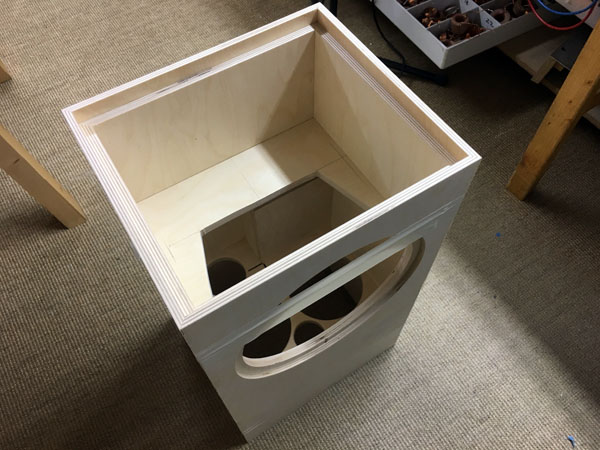
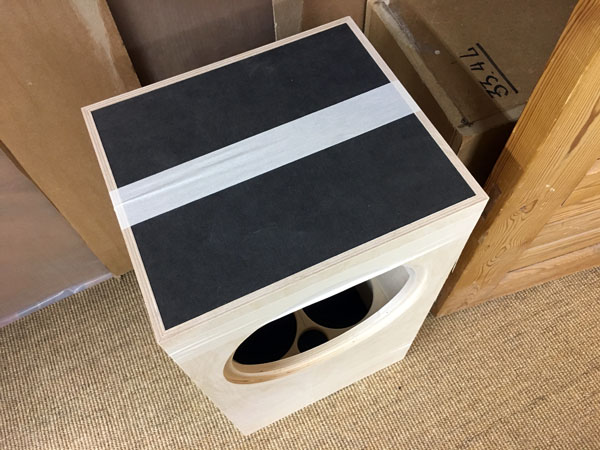
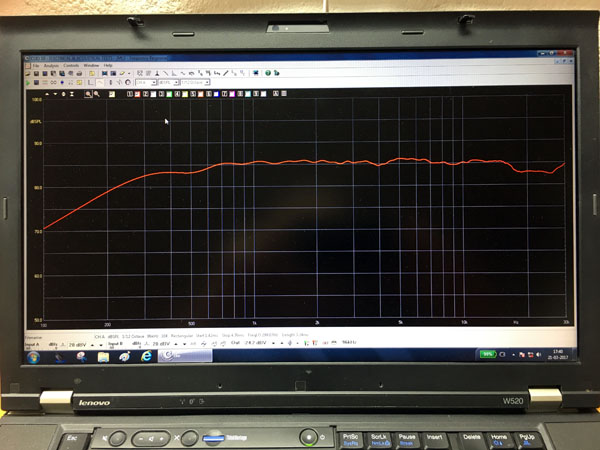
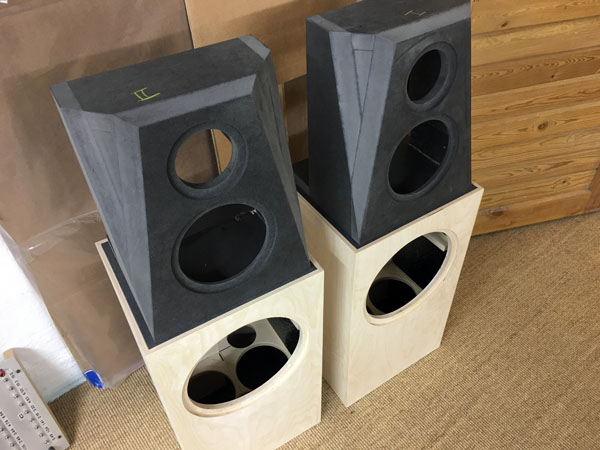
Left: MT frequency response during crossover development.
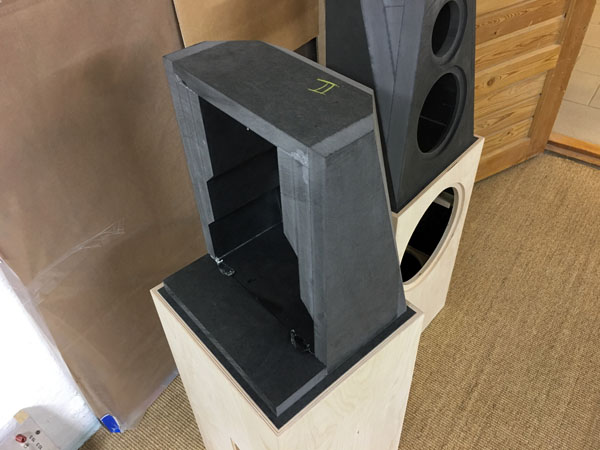
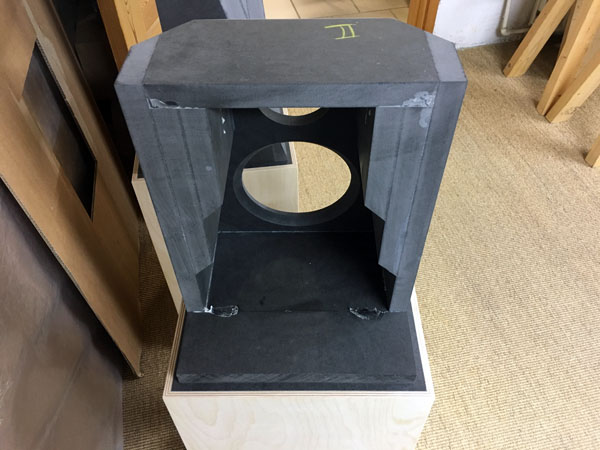
Trying out the MT section after gluing.
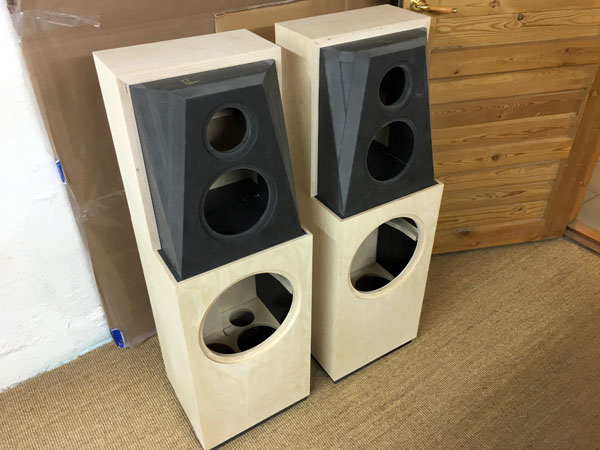

Left:
MT section ready for lacquer.Right: Prototype MT rear panel. Follow
instruction (drawing) and make one brace allowing crossovers for tweeter
and midrange to be mounted on rear panel.
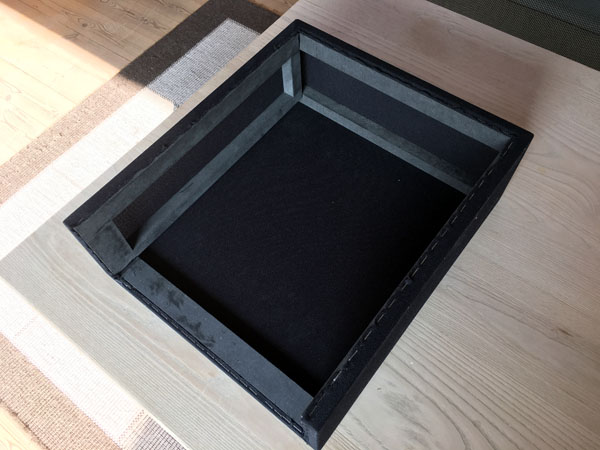
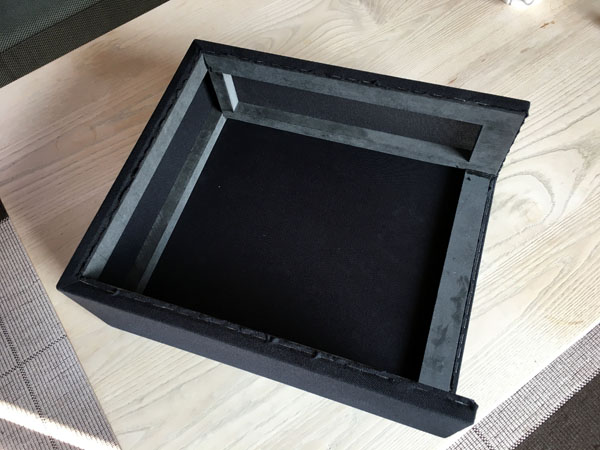
Front grille was made from 19x30 mm fillets of black MDF glued with
epoxy. Lower front bar was 12 mm MDF.
Cabinet damping:
Bass cabinet: Add 8 mm felt to all internal panels. Add 4 layers of 30
mm acoustilux at the bottom and two layers behind and bass driver and on
top of the cabinet.
MT cabinet: Add 8 mm felt to all internal panels except rear panel. Add
two layers of acoustiux on top of crossover.
Port: 50 x 145 mm. Cut a piece of 12 x 20 cm acoustilux and stuff the port (= aperiodic tuning).
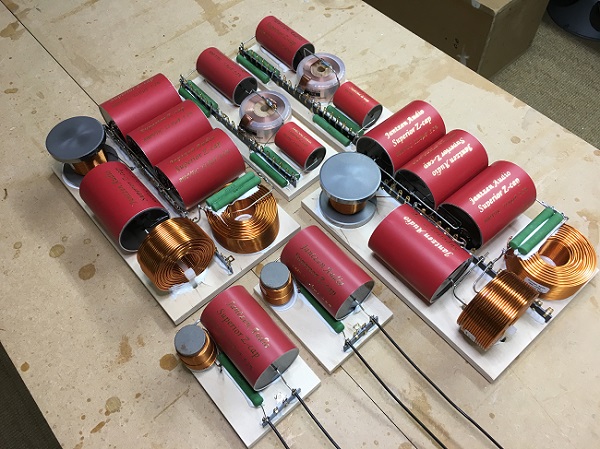

Left: Prototype crossovers. Different from the final crossover layout. I
hadn't realised the size of the caps....
Right:
Living room fine-tuning.
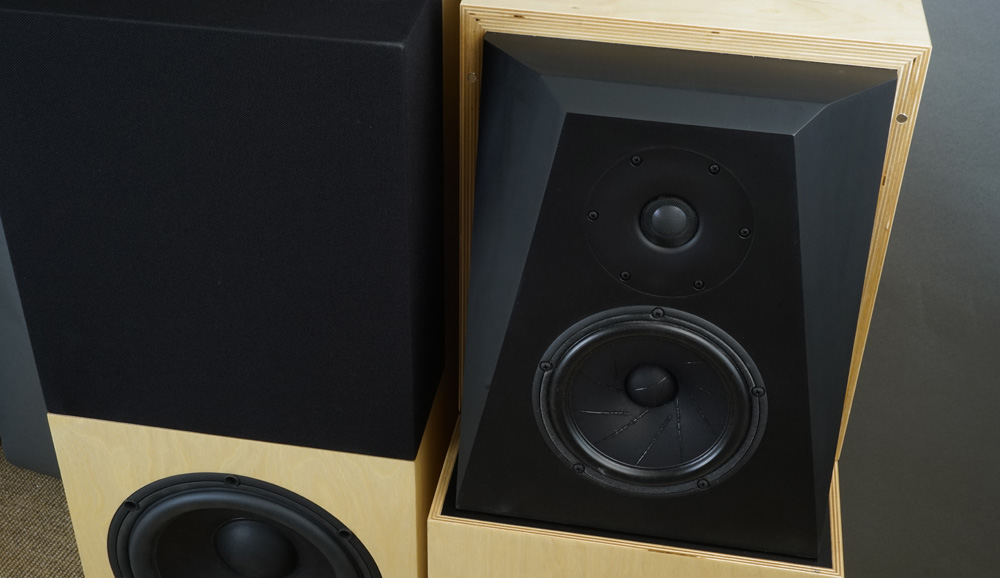
I use 8x8 mm neo magnets for holding the grille frame in place.
Everything that can be counted does not
necessarily count; everything that counts cannot necessarily be counted".
Albert Einstein.
A few comments on MEASUREMENTS before you start
interpreting all the readings below.
First of all, if we think measurements will tell us how a speaker
sounds, we're wrong. The perception of sound is way too subjective to be
reflected in any measurements we can perform. A loudspeaker system is
meant to give us a satisfying idea of an acoustic event and for some
people a pair of 5 USD ear-plugs are enough, others spend 200 kUSD on a
truly full-range pair of speakers - and the latter may not be happier
than the former.
Measurements may give us an idea of tonal balance of a system, i.e. too
much or too little energy in certain areas. Measurements may tell us
about bass extension if far-field measurements are merged with
near-field measurements. In addition to this, ports may contribute to
bass extension. Most of us diy'ers do not have access to an anechoic
room for full-range measurements from 20-20000 Hz.
What cannot be seen is what kind of bass performance we get in a given
room. Bass performance is highly dependent on in-room placement of your
speaker and the same speaker can be boomy in one place and lean in
another. Actual SPL level at 1 meter distance and 2.8V input is useful
for en estimate of system sensitivity and combined with the impedance
profile may give an idea of how powerful an amplifier is needed to drive
the speaker to adequate levels.
What measurements do not tell is the very sound of the speaker unless
displaying serious linear distortion. The level of transparency, the
ability to resolve micro-details, the "speed" of the bass, etc., cannot
be derived from these data. Distortion measurements rarely tell much
unless seriously bad, and most modern drivers display low distortion
within their specified operating range.
Many people put way too much into these graphs and my comments here are
only meant as warning against over-interpretation. There are more to
good sound than what can be extracted from a few graphs. Every graph
needs interpretation in terms of what it means sonically and how it
impacts our choice of mating drivers, cabinet and crossover design.
What measurements certainly do not tell is the sonic signature of the
speaker, because speaker cones made from polypropylene, aluminum, Kevlar, paper, glass
fiber, carbon fiber, magnesium, ceramics or even diamonds all have their
way of adding spices to the stew. Nor do measurements tell what
impact the quality of the crossover components add to the sound, from
state of the art components to the cheapest of coils and caps, they all
measure the same if values are correct.
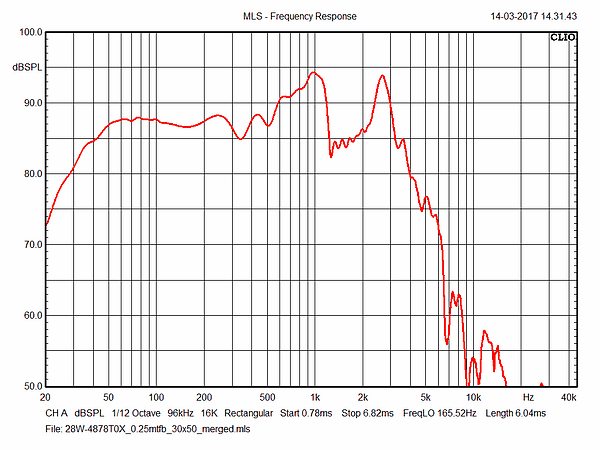
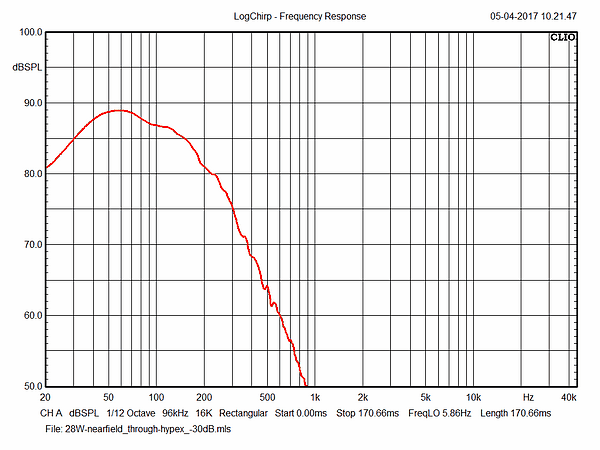
Left: SPL from bass driver, no crossover. Right: Bass response driven
from Hypex.
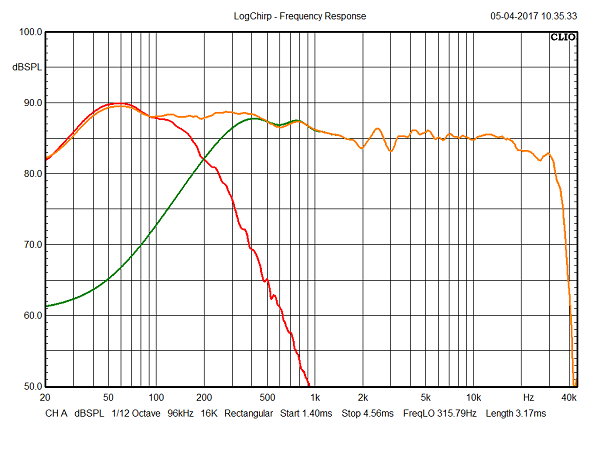
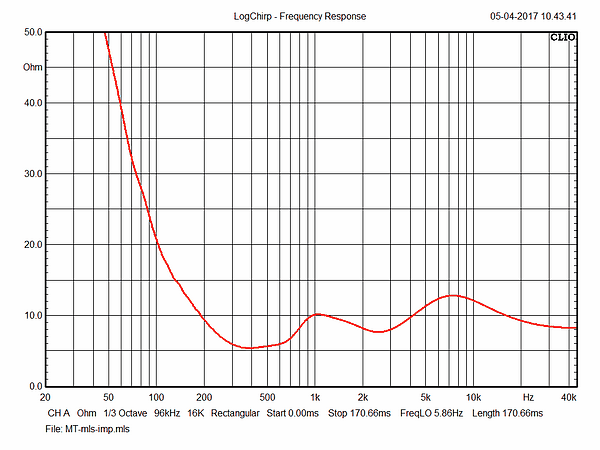
Left: SPL og bass, MT section and summed response. Right: Impedance of
MT section.
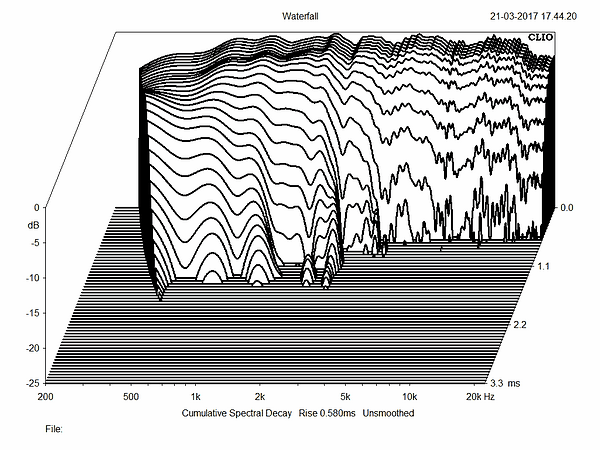
Left: CSD of MT section.
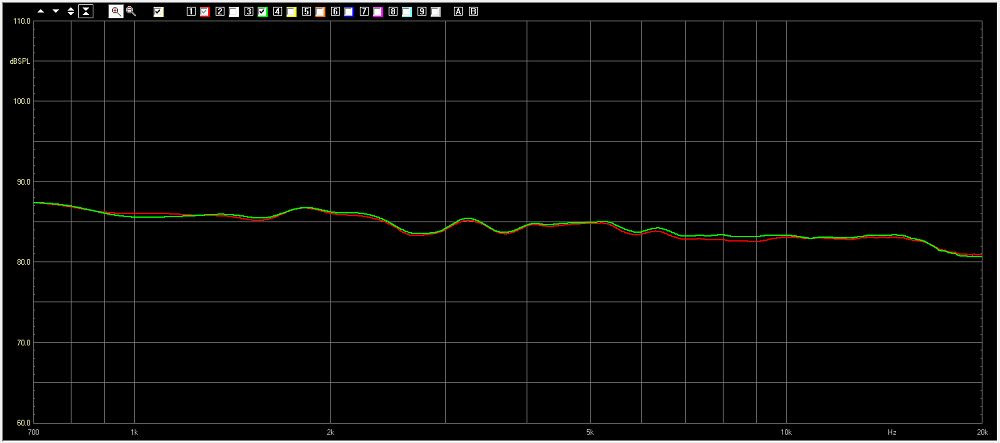
Left and right speaker. Quite a matched pair. Tweeter at highest
attenuation.
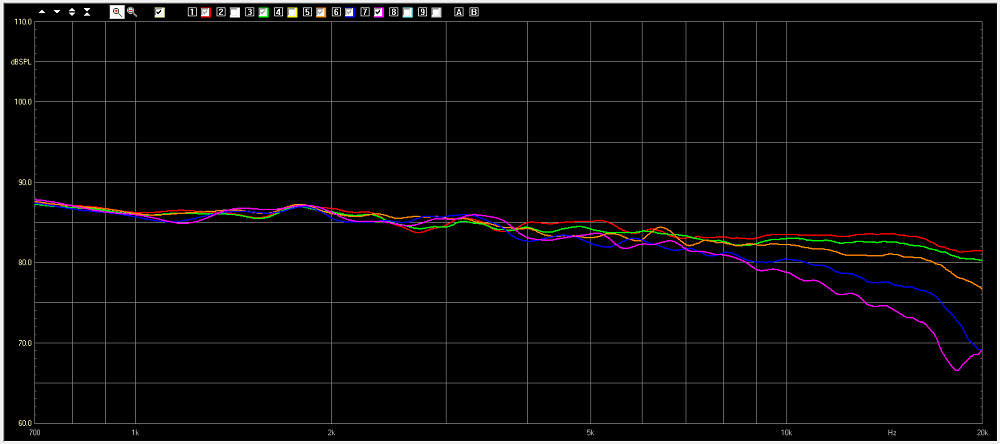
Horizontal dispersion at 0, 10, 20, 30 and 40 deg. off-axis.
Very even frequency response up to 10 kHz over a 60 deg. window.
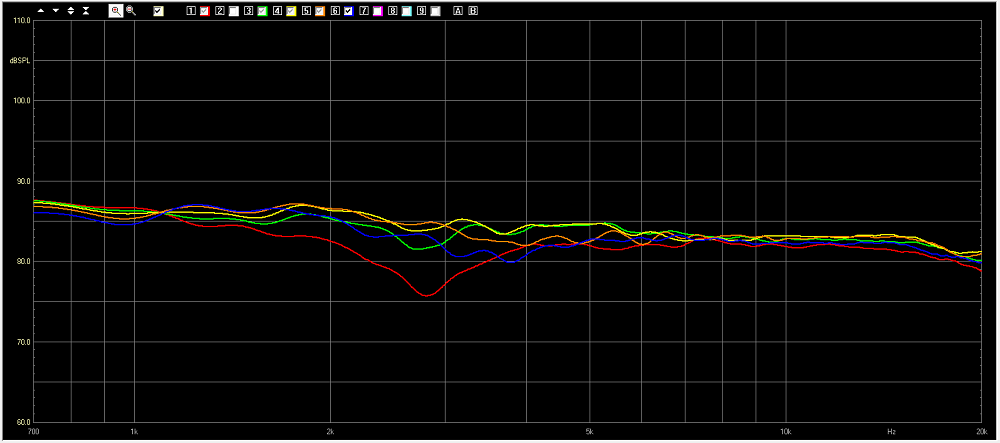
Something we rarely see: Vertical dispersion.
Here measured at 0.5 m distance at a height starting at the lower edge
of the 18M driver (red) up to the upper edge of the cabinet (blue)
(red-green-orange-yellow-blue)
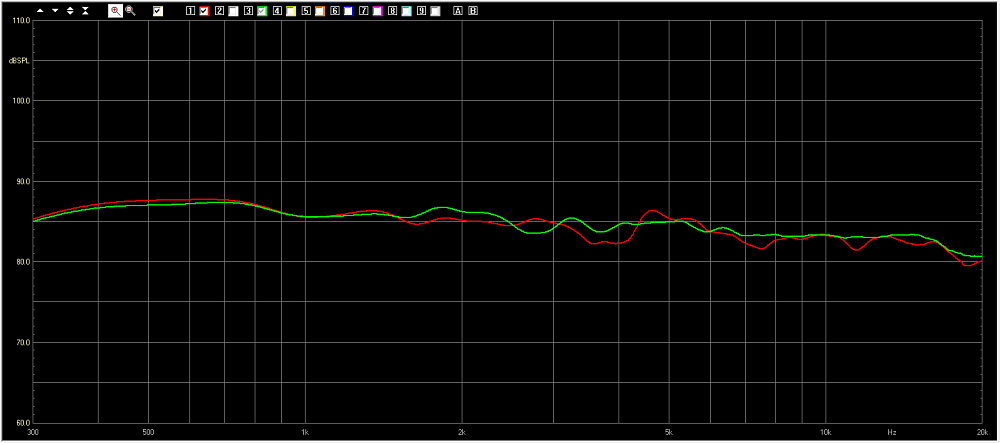
Front grilles usually ruin the party, but here we have the response at 0
(red) and 10 deg. (green) off-axis.
Listening at e.g. 10 deg. off-axis provides a rather smooth response.
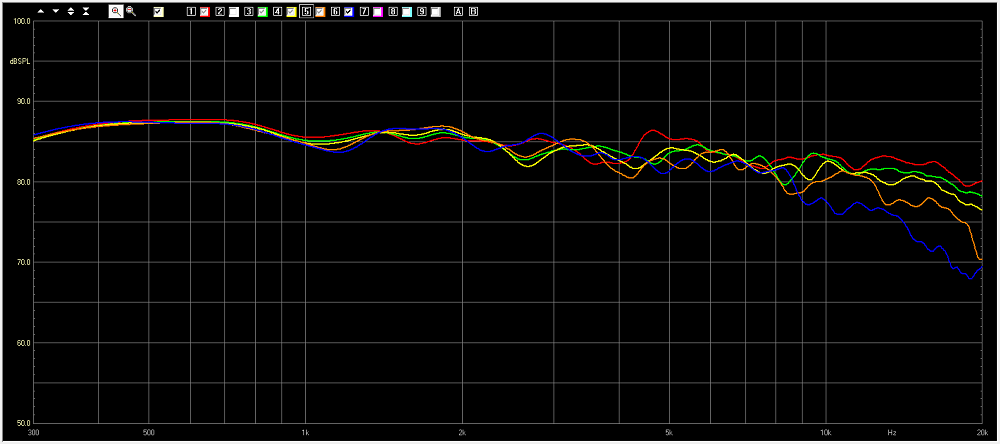
Same again, here at 0, 10, 20, 30 and 40 deg. off-axis with
front grille.
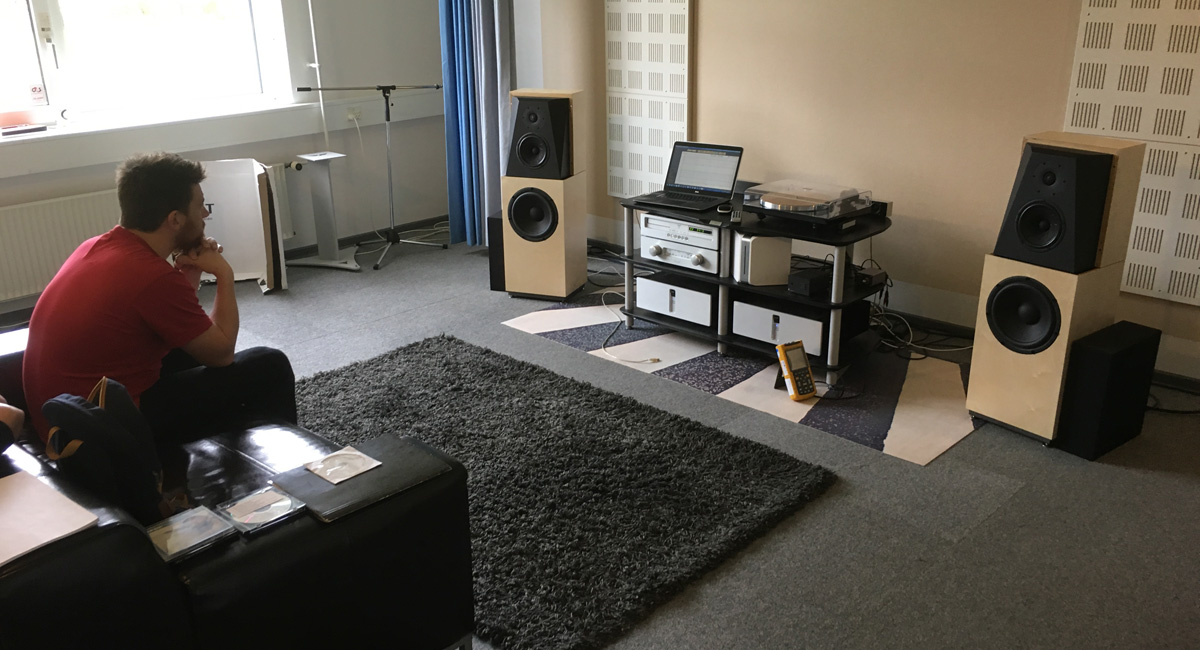
Speakers at ScanSpeak demo room in Videbaek
Gamut front-end.
SPEAKER-PARTS
LIST
BACK TO INDEX
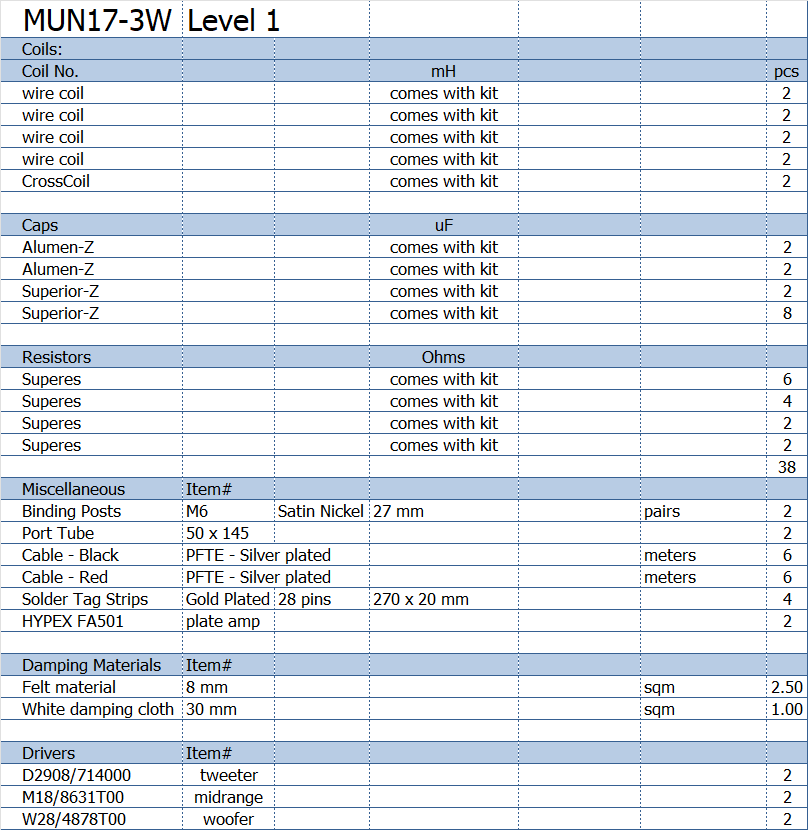
Parts list can be bought for 100€, payment by PayPal.
Mail
troels.gravesen@hotmail.com
CROSSOVER-LAYOUT
BACK TO INDEX
Layout for tweeter
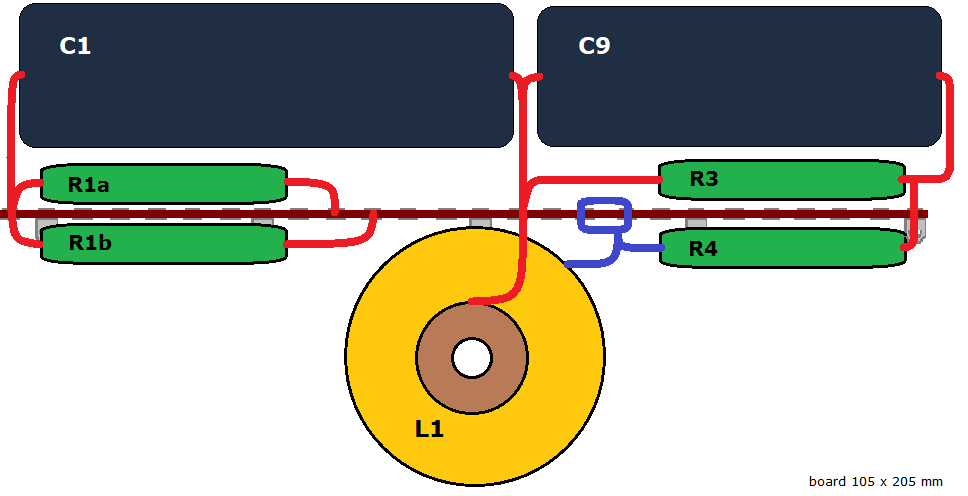
Layout for midrange
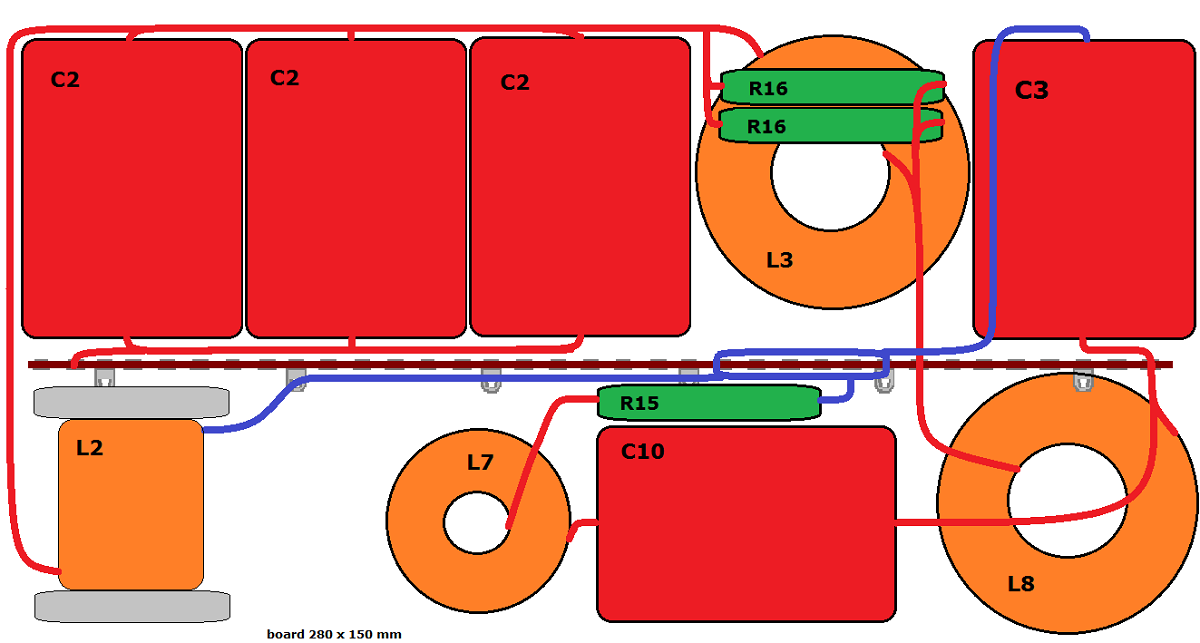
Speaker wiring, MT section
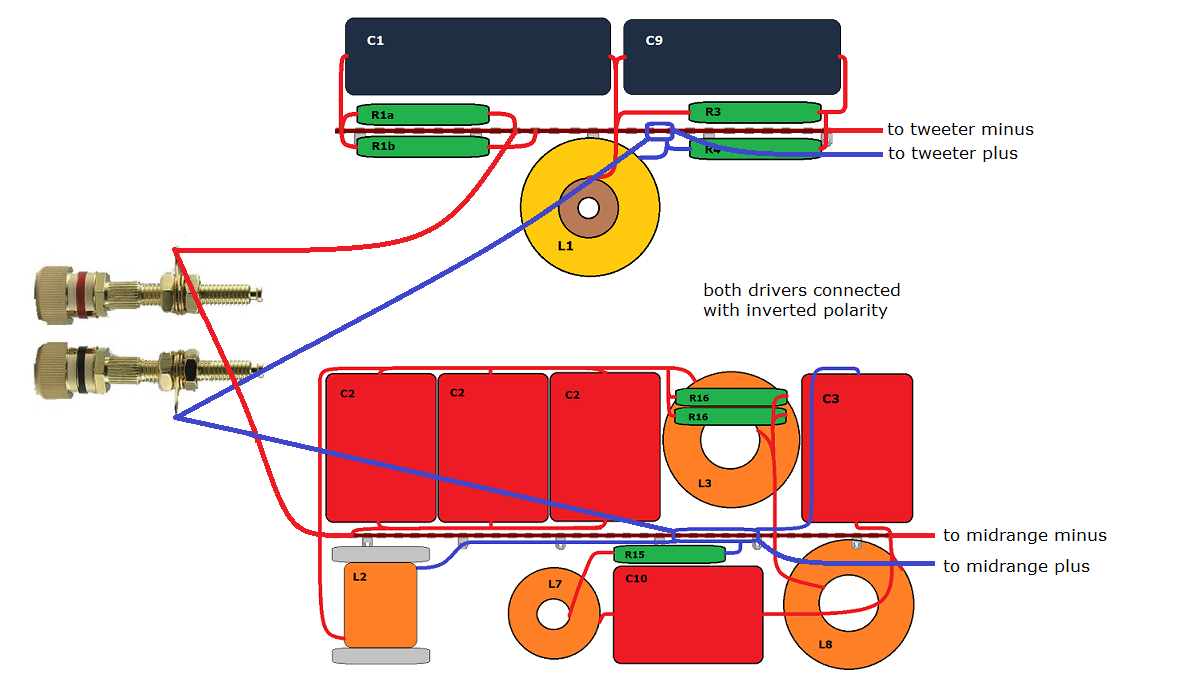
Placement of crossover on MT rear panel
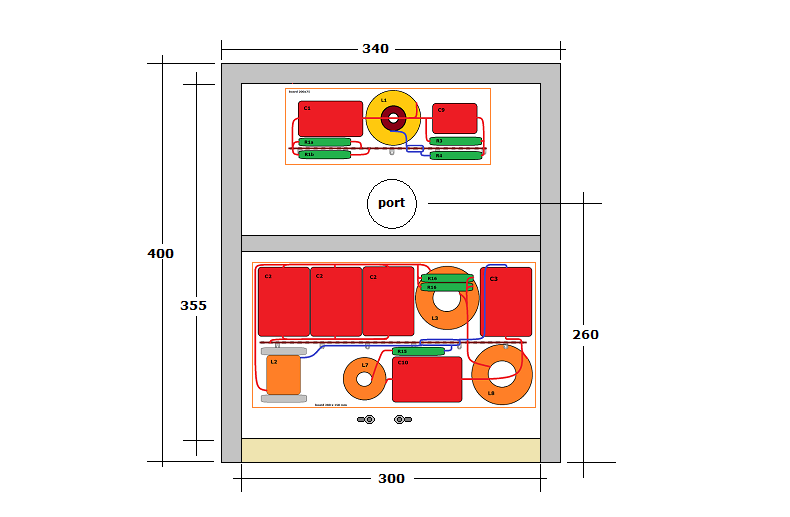
You may have the rear panel of the MT section removable for access to
the crossovers, because you can't mount the crossovers through the the
driver holes. The M section is too large for this.
